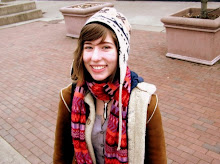Hello, Cleveland!

Call me a romantic, but 89 days left in Cleveland just got a little less daunting, a little less depressing last night as I drove down a little road called Starkweather in Tremont to its dead-end. I say romantic for it may have been the fault of the moon. As I turned the corner at 1 in the morning onto the crooked little road next to St Theodocius, there it was: poised high and elegant above the steelyards below. Strewn below that moon were the aching, broken ribs of the fallen steel companies of Cleveland's ashy past.
But it was the unworldly towers, the illuminated turquoise domes of St. Theodocius which rose like the hardened fists of an embittered, stubborn old Greek woman who would never return to her native country, that nudged the pedals of my car to a stop. I was seized by an urge to enter the church on the sloping hill that slid down to the steelyards. Seized by an urge to climb those sea turtle-colored domes, see the smoke-fires still bursting from the smoke stacks of an industry lay waste.
I drove on down the bumpy street with the narrow houses, leaving the Greek church behind for later investigation.
Hello, Cleveland! We meet again. I've lived and gone to church and school in you, in Parma with the Ukes and the Polaks and the pierced, chained Parma high school kids who still wander around looking like they're straight out of the 90s and listening to Nirvana. The suburbs festering and growing around the city until they reach the country roads and el paca farms and cornstalks of all-encompassing flat Ohio, which isn't much more interesting. Ohio City and Tremont condos on the outskirts of the ghetto to the growing gentralization. Cleveland of the foreclosure crisis, Cleveland of the Rock and Roll Hall of Fame, Cleveland of the lost causes we call the Indians, the Browns (and now the Cavs). Cleveland of LeBron James, Cleveland of the working-class, Midwestern "good place to settle down and have good kids and bring 'em up right."
Cleveland, the miserable metropolis. The mistake on the lake. Who began these phrases? Were they native Clevelanders, or were they the people in other cities like New York and L.A. who've never been to Cleveland? Or were they the people who were born and raised here and moved off to Chicago (like Cleveland, just way better!) or opposite coasts, and never wanted to come back and thus ridiculed the city they were lucky enough to escape?
These images of Cleveland, these recurring motifs of industrial wasteland, of broken down bridges in the Flats, of poor people with no opportunities, lost jobs, bad schools, artists moving out, sports teams losing over and over again ... These images are very real, but they've begun to drag down the people with them. What Clevelanders must remind themselves is that people are resilient: unlike the rusting, useless steelyards put to death, or a company, or money even; people, human beings, living things, are able to overcome obstacles and to survive, by sheer instinct and adaptability. It's hard-wired in us. We do not stop moving and lie in a field and rust away like a piece of metal--that is of course, until we are dead. But as living beings we are constantly on the rise and on the run.
Then what is it about most Clevelanders who have given in to the condescending people who call it a shithole? Where is the resiliency, the desire to survive and overcome? Perhaps it is the very fact that so many native Clevelanders feel so shitty about their city (about themselves) that it's become such a shithole.
On NPR's report, "How Cleveland Could Rise Again":
"In 1950, the population of Cleveland, Ohio, was almost a million people. Sixty years later, it's a third of that, due in part to the declining manufacturing base many formerly great cities have experienced..."
Where there are no people, there is no soul. Cleveland (the city, the idea) is struggling to bring both of those two things back.
(Note: the following reference might be a little too nerdy for some readers, but here goes):
Do you remember the last couple Harry Potter books, when Rowling introduced the idea of a Horcrux? Basically the idea was that Voldermort, by way of some intense magical power, was able to split his soul into seven pieces and hide them in various places and objects all over the world. This way, he would never die. If one Horcrux was discovered and destroyed, only 1/7 of his soul would be destroyed. But 6/7 of him would still exist and be nearly impossible to completely obliterate.
It was his way of achieving immortality.
Cities have a soul that is often split into hundreds and even thousands of little pieces, and cities with the strongest soul--with the greatest chance of resiliency and immortality--hide those pieces of soul in the most difficult places to find, the most hidden places, the most unexpected places. Even when a big chunk of that well-being has been destroyed, even when money drains out of a city along with 2/3 of its people, there are still pieces of soul embedded in the little things and neighborhoods. There is still a piece of soul in the way the turtle-shell turquoise dome of an old Greek church reflects the moon.
To all the Cleveland-haters (many Clevelanders themselves): Shut up and find your piece of soul. Or get out.
Labels: Personal Essays


1 Comments:
I need to get back. I need to feel that strange Cleveland scene.
Post a Comment
Subscribe to Post Comments [Atom]
<< Home